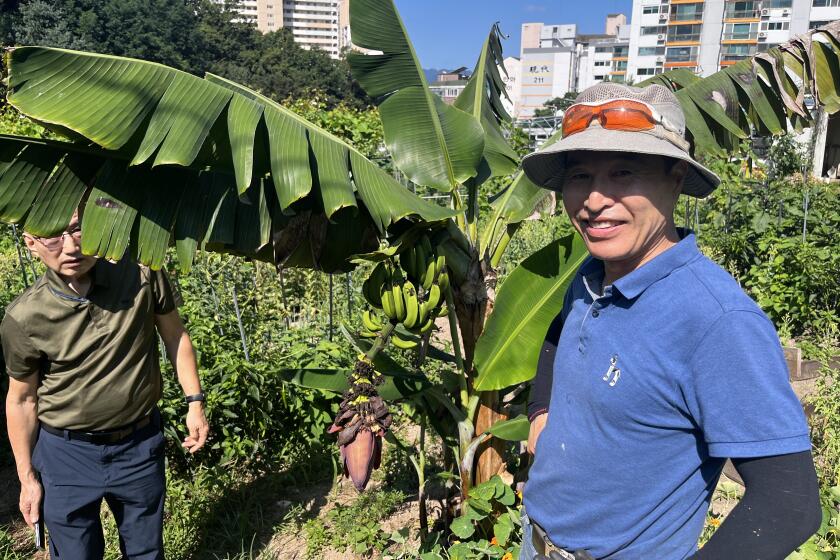Colorado town’s wildfire law called intrusive
Until its trees started dying, the Colorado ski resort town of Breckenridge stayed out of the business of telling residents how to defend their homes against wildfire.
But with trees ravaged by a mountain pine beetle epidemic that has left large rust-tinged swaths of forest vulnerable to a catastrophic fire, town officials decided this year they had to act.
Breckenridge, with a population of 3,500, recently passed an ordinance requiring residents to thin vegetation around their homes -- creating “defensible space” in firefighting lingo -- a move authorities say could help stanch a spreading blaze and aid firefighters in protecting homes.
But the new law has infuriated many residents, who call it an encroachment on their rights and demand its repeal.
“This country has always been based on the idea of private property ownership. It’s a sacred thing. The town’s ordinance pretty well tramples on that,” said Ed Nolan, 65, whose home is surrounded by 37 trees that firefighters say should go.
“If cutting these trees saves my life or my wife’s life or a firefighter’s life, then it’s worth it,” countered John Quigley, 59, who has hired a crew to thin some of the 185 trees on his land.
California long has required residents in wildfire-prone areas to trim vegetation, and Nevada lawmakers recently approved a similar law for homes in the Tahoe Basin, but other Western states have generally skirted such directives, instead employing public education campaigns to coax residents into doing so.
In recent years, many Colorado counties began requiring homeowners in new developments to create defensible space before building permits are issued. But there’s nothing authorities can do to compel them to maintain the clearance after they receive their permits, said Kevin Klein, director of the Colorado Division of Fire Safety.
Breckenridge’s tactic could signal a newly aggressive approach, he said, one that other communities may adopt as Colorado grapples with an infestation that has destroyed thousands of acres of trees and that fire officials fear will contribute to a conflagration.
“It’s a pretty dramatic shift from what we’ve been doing,” said Breckenridge Councilman Jeffrey Bergeron.
Surrounded by the White River National Forest, Breckenridge for years has focused more on making hillside homes blend in with their environs by encouraging landscaping around homes, Councilman Dave Rossi said.
Then came the beetles. When the town passed a law requiring residents to cut down infected trees, Rossi said few residents objected.
But fire officials thought such measures weren’t enough. Too many homes were surrounded by brush and trees, said Gary Green, chief of the Red, White and Blue Fire District.
Some residents regarded the proposal to require defensible space as necessary to protect the community. Relying on volunteers isn’t enough, Quigley said. “If you do it and your three adjoining neighbors don’t do it, you haven’t accomplished anything,” he said.
But others have objected to the mandate, citing the expense of removing healthy trees and shrubs and lowered property values.
“I now have trees that protect the master bedroom from a view of road,” Nolan said. “I’m going to pay to lessen the value of my property by taking out these trees.”
Opponents are circulating a petition seeking to compel the council to repeal the ordinance or put the matter on the ballot. They say they’ve collected more than the 330 signatures needed to qualify such a measure.
The opponents also contend there’s scant evidence that the town’s approach would be effective against a massive blaze, a criticism the fire chief disputes.
They have found a sympathetic ear in Rossi, one of two council members who voted against the ordinance.
Though Rossi believes residents should trim vegetation, he questions how effective the strategy can be in one town if neighboring communities don’t take the same approach.
“I’m not sure it gets us where we need to be,” said Rossi, noting that the town has not taken other important steps, such as requiring fire-resistant roofing materials.
But Bergeron, who was among five council members who supported the ordinance, rejects the argument that the town has overstepped its bounds.
“I sympathize with people who don’t want to cut trees. I’m a tree hugger,” he said. “But what I don’t buy is the argument that the government can’t tell me what to do on my property even if it saves lives and the property of my neighbors.”
More to Read
Sign up for Essential California
The most important California stories and recommendations in your inbox every morning.
You may occasionally receive promotional content from the Los Angeles Times.










